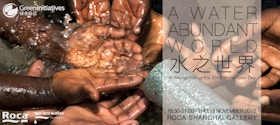One of the most shocking realizations to those who live in wealthy regions is the fact that 1/3rd of our global population does not have access to basic sanitation needs and 1/6th of the population lacks reliable drinking water sources. If nothing changes, it may still take several decades to fill the gap in water availability between developed and developing countries—several decades that people will be forced to spend without the health, dignity and well-being provided by clean toilets and safe drinking water.
In recognition of World Toilet Day, Green Initiatives presents a special event showcasing new breakthroughs in the fields of water usage and conservation.
As a continuation of our August event A World Without Water, where we discussed growing concerns in global water shortages and pollution, A Water Abundant World takes a glass-half-full view of the situation by focusing on innovation. Discussions will feature experts from various industries speaking on cutting-edge developments in their fields, including:
- POTABLE WATER AVAILABILITY - with constant research into efficient desalinization technologies and cost-effective filtration systems, it’s clear that the availability of potable water is a top priority. It is an issue that affects not only water-scarce regions of the developing world, but more and more major cities like those in China where most easily available water is full of unsafe contaminants, or Los Angeles where inhabitants suffer from constant drought conditions and over-tapped watersheds.
- HYGIENE CHALLENGES - sanitation in China is undergoing a massive transition while facing numerous challenges such as rapid urbanization, a widening gap between rich and poor as well as urban and rural areas. Health problems caused by the lack of safe water are exacerbated by poor sanitary conditions, especially in rural China.
- INDUSTRIAL WATER USAGE - even an item as simple as a t-shirt can take over 20,000 liters of water to produce, when taking into account growing the cotton and spinning the fabric it’s made from. With this massive water cost to all manufacturing processes, there are huge steps to be made in the reduction of industrial water usage, as well as the responsible treatment of water byproducts and runoff.
For more information or RSVP, please visit our website.
Sponsor/exhibitor contact
Green Initiatives
[javascript protected email address]
Publish your content with EB Publishing
It's about who you reach. Get your news, events, jobs and thought leadership seen by those who matter to you.











